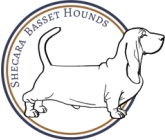Housetraining your Basset Hound Puppy
Part 3: TAKING PUPPY HOME
FIRST DAYS: You are going to want to take puppy out as often as possible. You want to give him every opportunity to succeed and potty outside. The more often you can ‘catch’ a potty outside and prevent an accident inside, the better. Initially, this is going to take up a lot of your time. A sample puppy schedule would be: wake up, potty, play, potty, eat, potty, nap, potty, play, potty etc. The entire day! Put the leash on the puppy, and have puppy walk to the potty area, don’t carry him. Give the potty bells a ring before you open the door to outside. Gently keep in him the potty area with the leash, waiting quietly. Once puppy has pottied, give soft, gentle praise and petting. Don’t startle the thought of what just happened out of his mind with wild whoops and hollers! The puppy will feel your happiness through calm praise. If nothing happens in 3-4 minutes, feel free to go back inside, but watch for signs that he needs to go (sniffing, circling, pausing in play). Young puppies, especially boy puppies, sometimes needs to urinate twice before their bladder is completely empty. So if your puppy tends to pee as soon as you get back inside, after an outside pee, just stay outside until he goes twice.
Your Shecara Basset Hound puppy has the general idea of pottying outside, but he doesn’t know how to hold it for long periods of time, and he doesn’t know how to tell you he needs to go. Building up control will come with age. The potty bells are often so much quicker for the puppy to learn to tell you he needs to go. So in order to teach him – at first right the bell every time you head out. After a week or so, once puppy knows the routine, pause in front of the door without ringing, and see what he does. If he moves towards, touches, or rings the bell, give gentle praise and head straight out. If not, give it a ring and proceed to potty area. He’ll get it soon enough. The first goal is that he potty’s when outside- the second goal is that he knows how to alert you by ringing the bells.
In addition to providing many opportunities for the puppy to do the right thing, ie: potty outside, you also want to reduce as much as possible, the opportunity for accidents. The best way to do this is to make sure that the puppy does not have unsupervised run of the house. That’s why we recommend you setup a safe, confined area indoors, where the puppy spends his unsupervised time (see Part 2: Preparation). For the initial puppy period, until the puppy shows signs of potty control, the puppy should be in the following 3 areas at all times.
1). Directly supervised by a dependable person that’s actively watching or engaging with the puppy. This person should be watching for signs that puppy may need to potty. Such as sniffing, circling, wandering off, suddenly stopping play, going off into a corner.
2). In his puppy pen. A general rule of thumb for the first months that the puppy is home: the puppy should be able to hold his bladder for as many hours as he is old in months. So when you take a 2 month old puppy home – count on taking him to potty at least every 2 hours.
3). Confined in an area where pottying is allowable. (outdoors in a fenced yard). Ideally after a potty session. It’s best if you head to the potty area first, while puppy is under supervision, and then allow the puppy to play and explore once he’s done pottying.
Remember that accidents will happen, it’s all part of the process. If possible, view accidents as your mistake, try to figure out what you can do to prevent another accident in the future. Don’t punish the puppy. Clean up the accident immediately, and use a cleaning product to get rid of the stain and smell to prevent a future accident. Sample stain and odor remover: Click here
INTO THE FUTURE:
As the puppy starts to demonstrate control with fewer accidents, you can learn his routine, gradually increase the amount of time in between potty breaks, (a few minutes at a time!) and allow the puppy more freedom in the home (very gradually!) Ideally, allow the puppy to ‘earn’ his freedom, first by making his pen area larger as he demonstrates control, and then allowing him access to one room at a time. Remember that this is a slow process, and taking your time will more quickly create control.
© Shelley Klok 2022
